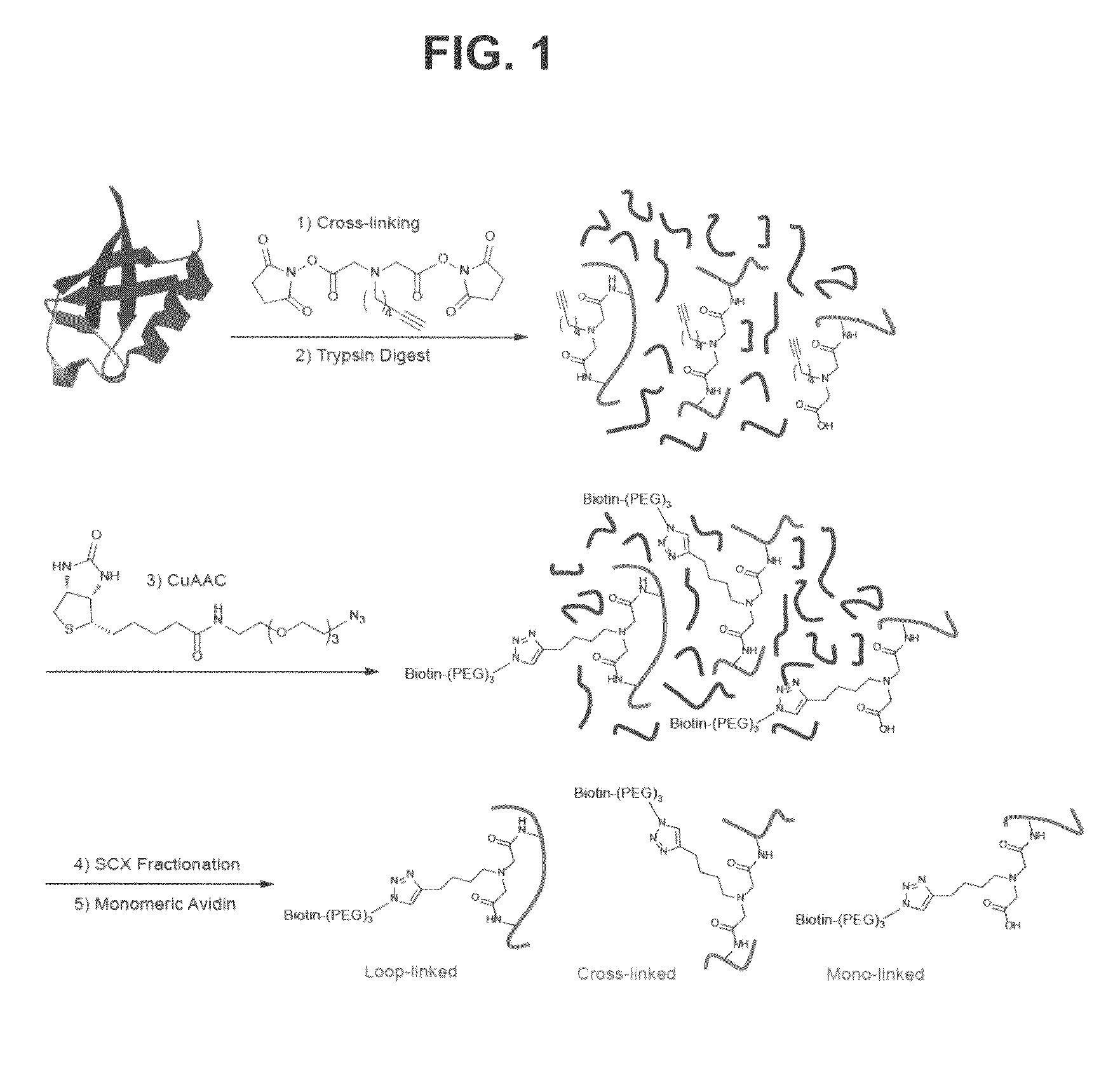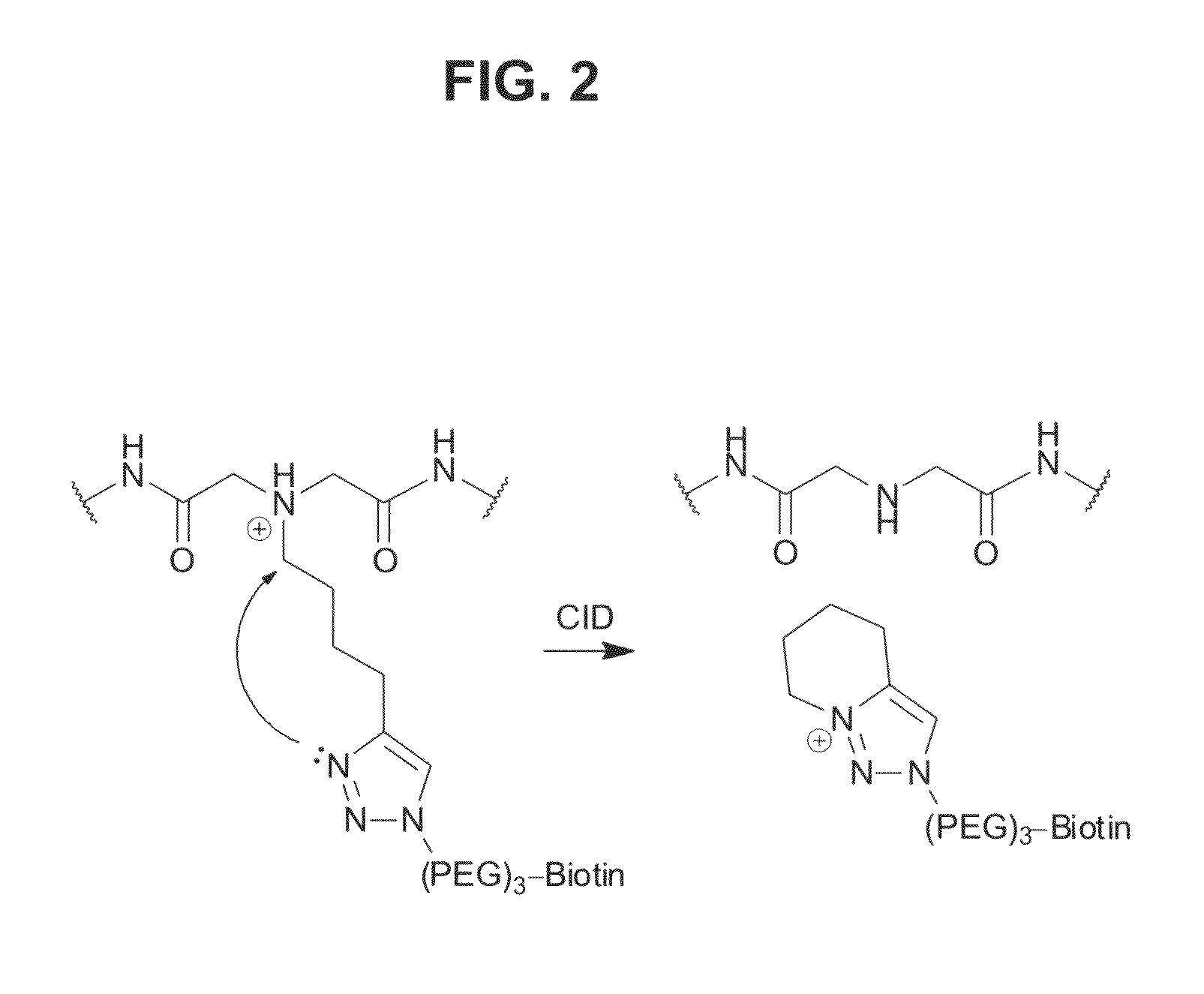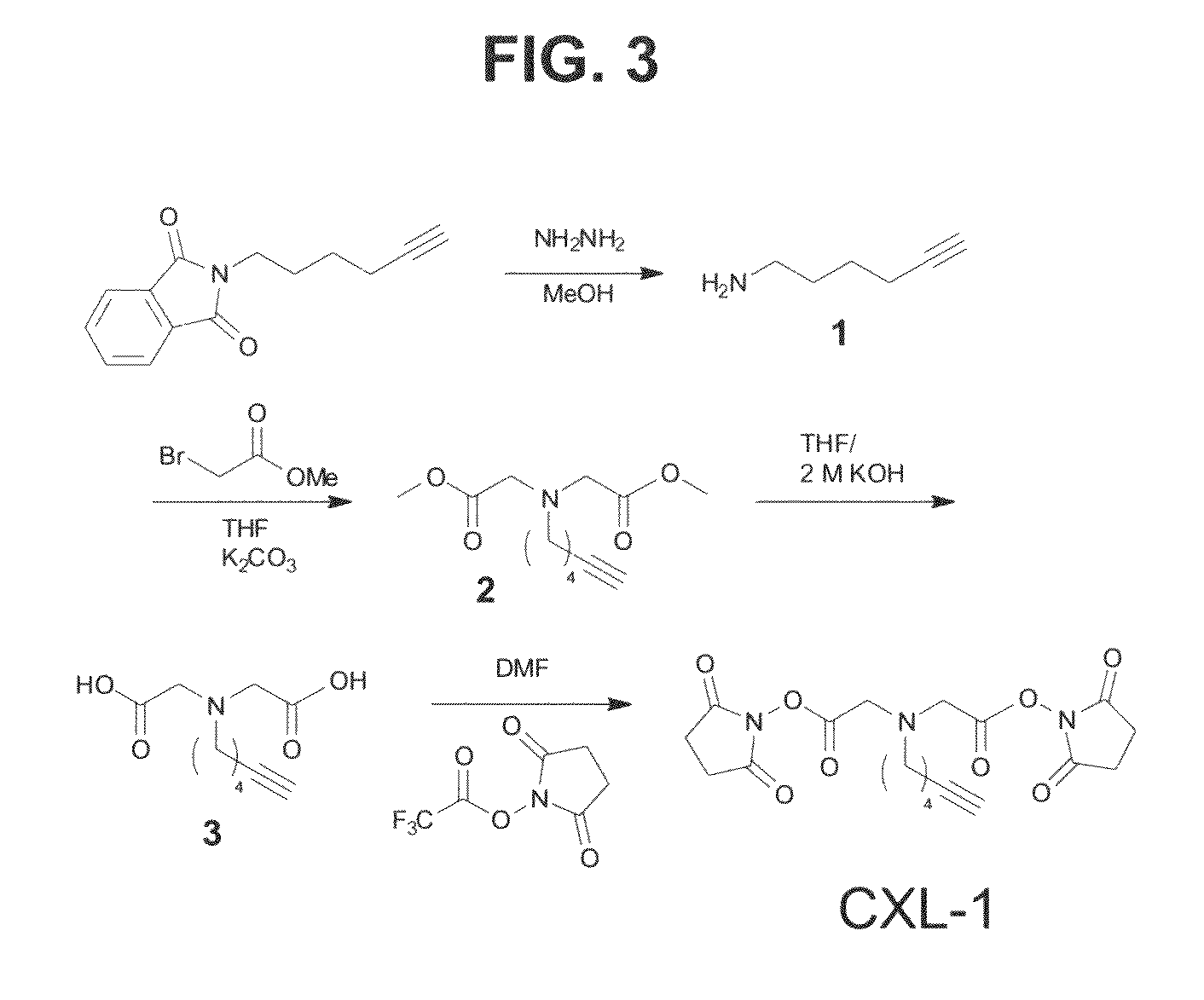Clickable cross-linker
a cross-linker and click-able technology, applied in the field of click-able cross-linkers, can solve the problems of not revealing detailed structural information relative to the nature of specific protein interfaces, requiring large amounts of sample analysis, and failing to identify weak binding partners
- Summary
- Abstract
- Description
- Claims
- Application Information
AI Technical Summary
Benefits of technology
Problems solved by technology
Method used
Image
Examples
example 1
Synthesis of Cross-linker Compound: NHS-2,2′-(hex-5-ynylazanediyl)diacetic acid
[0060]The general synthesis scheme is shown in FIG. 3. The reference numbers / names of the intermediates shown in the schematic are referred to and described here, e.g. (1), (2), (3), and CXL-1 are referred to in the below description of the synthesis scheme.
Synthesis of 6-Amino-hex-1-yne (1)
[0061]6-Amino-hex-1-yne was prepared from 2-(hex-5-ynyl)isoindoline-1,3-dione and hydrazine as described in the literature without modification (Nilsson et al.). The crude product was purified by flash chromatography (silica gel, dimethylene chloride:methanol=3:1 approximately 1:1) to yield 6-amino-hexyne as a pale greenish yellow oil. Yield was 30%. 1H NMR spectra were reproduced (Rozkiewicz et al.) ESI-MS [M+H]+ m / z 98.1. (Nilsson et al., J. Am. Chem. Soc. 2008, 130, 11297; Rozkiewicz et al., Angew. Chem.-Int. Edit. 2006, 45, 5292, the entire contents of both of which are herein incorporated by reference.)
Synthesis o...
example 2
Cross-Linking of Model Peptides.
[0066]A 50 μg portion of the model peptide, Ac-AAKAAAAAKAR (SEQ ID NO: 1) or Ac-AAAAKAAAAAR (SEQ ID NO: 2) (98% purity) was dissolved in 50 μL of HPLC-grade H2O. A mixture of 5 μL CXL-1 stock solution (10 μg / μL in DMSO), 5 μL Ac-AAKAAAAAKAR (SEQ ID NO: 1) or Ac-AAAAKAAAAAR (SEQ ID NO: 2) stock solution (10 μg / μL), and 15 μL ACN was prepared. The mixture was allowed to react at room temperature for 1 h. The reaction was terminated by adding 5 μL formic acid (FA). The solvent was completely removed by speed-vac, and the residue was reconstituted in 100 μL of 0.1% FA (aq) with additional 2 μL FA to further acidify. The resulting solution was desalted using an OMIX-C18 tip (100 μL capacity) following the standard procedure. The cross-linked peptide (approximately 50 μg) was eluted in 100 μL solution of 0.1% FA, 50% ACN and 50% H2O, and 5 μL of the eluted cross-linked peptide solution was diluted to 5 μM by 0.1% FA, 50% ACN, and 50% H2O, and analyzed by a ...
example 3
Cross-Linking of Ubiquitin
[0069]The general reaction summary of the cross-linking of ubiquitin (PDB ID: 1 UBQ) according to this Example is shown in FIG. 3. Twenty micrograms of ubiquitin were dissolved in 200 μL of 1×PBS (pH=7.4), and 1.2 μL of 50 mM CXL-1 stock solution in DMSO was added and the resulting mixture was reacted for 30 min at room temperature. The reaction was quenched by 50 μL of 100 mM Tris-HCl buffer (pH=8.5) and incubated for 15 min. The cross-linked ubiquitin was concentrated to approximately 30 μL and the buffer was exchanged to 100 mM ammonium bicarbonate at pH 8.5 using Microcon YM-3K spin filter units. The trypsin digest reaction volume was adjusted by adding 185.5 μL of 100 mM ammonium bicarbonate buffer containing 2 M urea, and 2.5 μL of 100 mM CaCl2. Two microliters of 0.5 μg / μL trypsin in 5 mM acetic acid (proteins:trypsin=20:1 w / w) was added and incubated for 15-18 h at 37° C. The reaction was terminated by addition of 5% FA (aq). The resulting tryptic d...
PUM
| Property | Measurement | Unit |
|---|---|---|
| volume | aaaaa | aaaaa |
| pH | aaaaa | aaaaa |
| volume | aaaaa | aaaaa |
Abstract
Description
Claims
Application Information
 Login to View More
Login to View More - R&D
- Intellectual Property
- Life Sciences
- Materials
- Tech Scout
- Unparalleled Data Quality
- Higher Quality Content
- 60% Fewer Hallucinations
Browse by: Latest US Patents, China's latest patents, Technical Efficacy Thesaurus, Application Domain, Technology Topic, Popular Technical Reports.
© 2025 PatSnap. All rights reserved.Legal|Privacy policy|Modern Slavery Act Transparency Statement|Sitemap|About US| Contact US: help@patsnap.com



